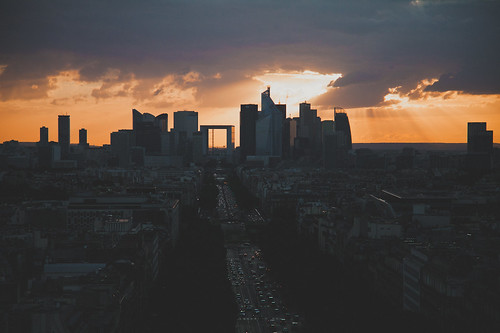 |
| Meet Rosaura! (photo courtesy: Andres Perez) |
Tell us a little bit about yourself—school, background, major, reasons for taking this trip, anything else interesting you want to share.
 |
| Rosaura (far right) with Andres and Charis at the Opera House (photo courtesy: Kyubo Yun) |
 |
| The most contemporary architecture of Paris can be found in the section of the city known as La Defense (photo courtesy: Kyubo Yun) |
Give us some insight into your assigned art work from the
Musee d’ Orsay. After seeing the work in person, what struck you most about it
and/or how did the art work’s form, content, and context shift for you when
seeing it?
 |
| Berthe Morisot, Young Girl in a Ball Gown (1879) |
In our visit to The Orsay, I came across my assigned
painting Young Girl in a Ball Gown by Berthe Morisot on the 5th floor
in the Impressionists Exhibition. The painting is average sized and positioned
in the left corner of the third room from the entrance, with soft but colourful
tones, and seemed to radiate for me as I impatiently looked around for it. I
didn't like where she was positioned because I think it is an amazingly
beautiful painting that deserves a lot more recognition than it has been given
by placing it on a corner and next to a painting of flowers. On the other hand,
I was surprised to notice that the colours were a lot brighter than I was
expecting based on the internet images. I also noticed that the texture
was incredibly thick especially on the dress where you could see some extreme
relief on the flowers, which I'm pretty sure was intentional as it only appears
in that region. The brush strokes were very obvious, which made the looseness
with which the Impressionists painted very visible. I was able to see Berthe
Morisot's intention of going against The Salon's idealistic techniques a lot
more. I was also able to see a lot of different strokes and details that I
couldn't see on the pictures, such as a red stroke or line on the right side of
the background, which made me wonder whether it was an accident or Morisot
intentionally wanted that line there as well as other little details that could
be argued or be seen as mistakes by others.
Today’s activity was at the Palais de Tokyo and the Paris
Museum of Modern Art. What were your impressions? What will you take away
of the experience? What, if any are the memorable moments for you?
 |
| One of several Dana Wyse packages designed to solve culturally percieved "problems" with a simple pill |
Today the group split into two groups, some of us went to
Palais de Tokyo's Intense Proximities contemporary exhibition and
others to the Musee d' Art Moderne de la Ville de Paris for the Robert Crumb retrospective exhibition. Intense Proximite addressed
several ideas such as the crisis of universality, cohabitation and coexistence
and linked them to race and ethnicity. The first impression I got from the
exhibition was that everything was very well spatially placed. There was a
perfect spot for everything, which made me wonder if the spaces were built
around the art works or the art works were built to fit the space. The first
floor was full of performance/video art that strangely and, maybe
unintentionally, interacted with each other; however, they also addressed
interesting subjects that in and of itself were interesting enough. Everything
was bright and colourful surrounded by white walls. The underground floor had a
very different feel to it: the whole floor was under construction and
everything was very dark and somewhat scary. After walking around it for a bit,
it made me wonder if they intentionally wanted the space to look under
construction or it was something they couldn't help and decided to go with
it. Similarly, the stairs hid art and history in them, filled with
graffiti and some art pieces that I'm not sure if were there because they
couldn't fit in the exhibition spaces or the artists intentionally wanted the
pieces to be located next to the stairs. Everything seemed confusing and
fascinating at the same time. I started to think that every single square inch
inside the Palais de Tokyo was part of the exhibition and not just the
exhibition rooms. When I reached the Bookshop, as we were about to leave, I
realized my theory was right as another hidden art piece struck me by surprise.
Dana Wyse's Jesus Had a Sister Productions has to be my favourite
project featured in all of the exhibitions. Her art work, camouflaged as
products that can be bought in the bookstore, consist of pills and other altered
random objects, such as cigarettes and coins packaged in small little bags with
labels that assure consumers that life could be made a lot easier by simply taking
a pill and instantly solving extremely sensitive problems of contemporary
society.
 |
| Rosaura and Amanda enjoying themselves at the Palais de Tokyo. |
